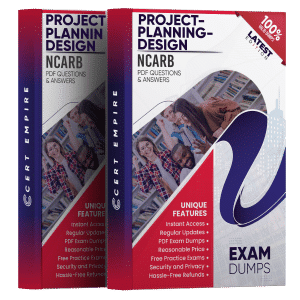NCARB Project-Planning-Design Exam Question 2025
Our Project-Planning-Design study materials provide up-to-date, authentic exam questions for the Project Planning and Design certification. Each question comes with verified answers, detailed explanations, and references for thorough understanding. With access to our online practice platform and sample questions, professionals trust Cert Empire to prepare effectively and confidently for the Project-Planning-Design exam.
What Users Are Saying:
Importance of Project-Planning-Design Exam
The Project Planning and Design (PPD) division of the NCARB ARE 5.0 is one of the most critical steps toward becoming a licensed architect. It sits at the intersection of creativity and technical expertise, asking candidates to demonstrate their grasp of both conceptual design and real-world application. In 2025, with architectural practices rapidly modernizing, this exam has only gained more importance. Candidates who aim to make an impact in the built environment know that passing PPD is more than just checking a box; it validates that they can connect design thinking with safety, structure, and user needs.
NCARB and its role in licensure
The National Council of Architectural Registration Boards (NCARB) sets the standard for architectural practice in the United States. By overseeing the ARE 5.0 exams, NCARB ensures that architects meet professional and ethical benchmarks that protect the public. The Project Planning and Design exam is one of six divisions that collectively lead to licensure.
What makes PPD unique in the ARE 5.0 lineup
Unlike some other divisions, PPD evaluates a candidate’s ability to balance aesthetic goals with structural requirements. It’s not just about knowing theory but also about applying codes, environmental considerations, and user needs to create functional designs.
Who should consider this division
This exam is for anyone on the licensure track but especially fits candidates with a solid foundation in design studios and prior exposure to environmental systems. If you’re someone who thrives on integrating art with practical problem-solving, PPD will test your strengths.
Career opportunities after clearing PPD
Clearing PPD unlocks career progression, moving candidates closer to licensed architect status. With licensure, professionals can work independently, take on large projects, and lead design teams. Many firms consider PPD a benchmark of readiness for mid-level positions.
Key skills covered in PPD
Passing this division shows mastery in several areas, including:
- Building design principles
- Site analysis and programming
- Environmental and sustainability factors
- Accessibility and code compliance
Difficulty level of PPD
Among the ARE 5.0 divisions, many candidates describe PPD as demanding because of its breadth. It spans design judgment, technical rules, and documentation. The length of the test makes endurance just as vital as knowledge.
Long-term payoffs for passing
Once licensed, architects often move into roles with more responsibility, such as project architect or design manager. Passing this exam doesn’t just push you closer to the license but also demonstrates commitment and capability to employers.
Roles and earnings connected to PPD success
Candidates completing the ARE 5.0 journey, including PPD, frequently step into well-paid roles. For reference, the PPD Salary average for licensed architects in the U.S. falls around $85,000 to $110,000, with higher ranges for those in metropolitan areas or large firms.
A Closer Look at the ARE 5.0 Project Planning and Design Exam
The ARE 5.0 Project Planning and Design exam measures your ability to develop creative yet functional design solutions. It validates that you can balance technical codes, budget constraints, and environmental needs while designing spaces that work for people.
Domains you’ll face in PPD
The official exam divides content into distinct areas:
- Environmental conditions and context
- Codes and regulations
- Building systems and integration
- Project integration of program and systems
- Project costs and budgeting
Breaking down the official PPD syllabus
The PPD Syllabus includes site design, zoning laws, environmental systems, structural integration, accessibility, and sustainability. Candidates are tested on their ability to combine these elements into cohesive solutions.
Question format in the exam
Candidates encounter multiple-choice questions, case studies, and hotspot items. The mix ensures that knowledge is tested both in isolation and within realistic project scenarios.
Weight of each area
Each content domain carries different weight. For example, site design and integration of systems often hold more value, signaling to candidates where deeper focus is needed.
Avoiding common mistakes
One frequent misstep is ignoring time management. Many candidates spend too long on one case study and then rush the rest. Another mistake is skimming codes instead of practicing applying them.
Practical tips for preparation
Smart preparation includes:
- Practicing with mock exam questions
- Reviewing codes directly from official documents
- Setting a timer for all practice sessions
- Taking full-length tests to build stamina
Study resources that help
Candidates often rely on a blend of official guides, practice questions, and exam prep materials. Tools like architectural reference manuals and flashcards help reinforce knowledge, but simulation-based practice remains the gold standard.
How long to prepare before scheduling
While timelines vary, most candidates take 8–12 weeks of consistent study before attempting the PPD Test. Short daily study sessions often prove more effective than occasional marathon reviews.
2 reviews for NCARB Project-Planning-Design Exam Question 2025
Discussions
There are no discussions yet.



Quentin Piper (verified owner) –
I took the Project-Planning-Design exam and felt confident after reviewing the study resources and practice tests. They were very helpful and ensured I was ready to tackle any questions that came my way.
Andrew Brown (verified owner) –
A coworker recommended Cert Empire for Project-Planning-Design prep, and it didn’t disappoint. The content was clear, concise, and completely relevant to the exam.